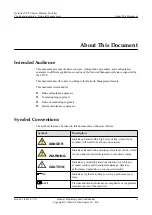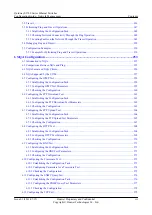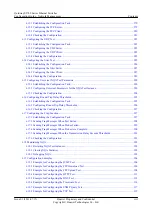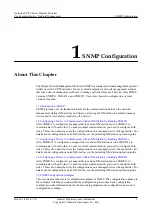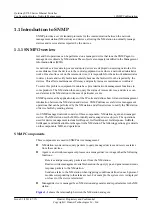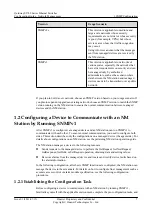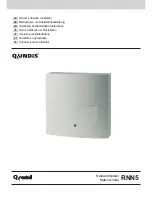
1.1 Introduction to SNMP
SNMP provides a set of standard protocols for the communication between the network
management station (NM station) and devices, allowing the NM station to normally manage
devices and receive alarms reported by the devices.
1.1.1 SNMP Overview
Get and Set operations can be performed on a managed device that runs the SNMP agent to
manage device objects by NM stations These objects are uniquely identified in the Management
Information Base (MIB).
As network services develop, more and more devices are deployed on existing networks. It is
some distance from the devices to the central equipment room where a network administrator
works. Once faults occur on the remote devices, it is impossible for the network administrator
to detect, locate and rectify faults immediately because the faults will not be reported by the
devices. This affects maintenance efficiency and greatly increases maintenance workload.
To solve this problem, equipment vendors have provided network management functions in
some products. The NM station then can query the status of remote devices, and devices can
send alarms to the NM station in the case of particular events.
SNMP operates at the application layer of the IP suite and defines how to transmit management
information between the NM station and devices. SNMP defines several device management
operations that can be performed by the NM station and allows devices to notify the NM station
of device faults by sending alarms.
An SNMP-managed network consists of three components: NM station, agent, and managed
device. The NM station uses the MIB to identify and manage device objects. The operations
used for device management include GetRequest, GetNextRequest, GetResponse, GetBulk,
SetRequest, and notification from the agent to the NM station. The following sections give details
on the components, MIB, and operations.
SNMP Components
Three components are used in SNMP device management:
l
NM station: sends various query packets to query managed devices and receives alarms
from these devices.
l
Agent: is a network-management process on a managed device. An agent has the following
functions:
–
Receives and parses query packets sent from the NM station.
–
Reads or writes management variables based on the query type, and generates and sends
response packets to the NM station.
–
Sends an alarm to the NM station when triggering conditions defined on each protocol
module corresponding to the alarm are met. For example, the system view is displayed
or closed, or the device is restarted.
l
Managed device: is managed by an NM station and generates and reports alarms to the NM
station.
shows the relationship between the NM station and agent.
Quidway S2700 Series Ethernet Switches
Configuration Guide - Network Management
1 SNMP Configuration
Issue 01 (2011-07-15)
Huawei Proprietary and Confidential
Copyright © Huawei Technologies Co., Ltd.
2



